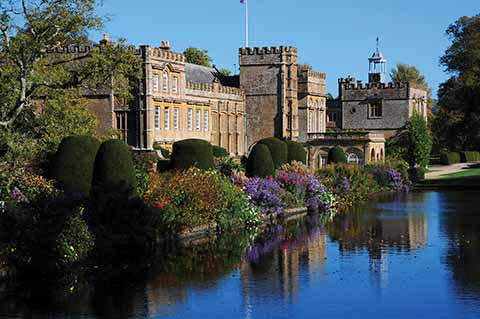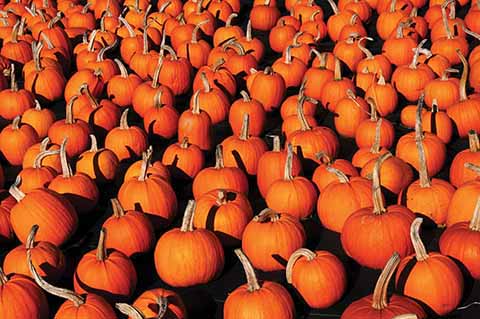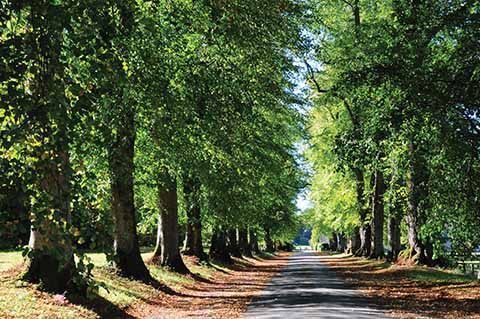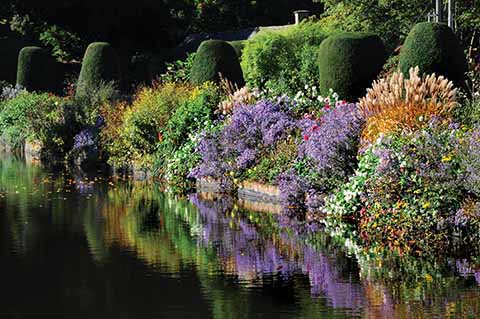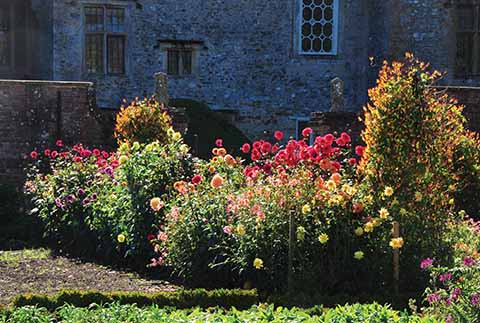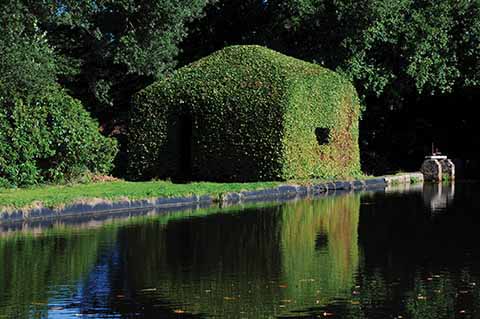The Dorset garden – Forde Abbey Gardens
In their last article on a Dorset garden for Dorset Life, Colin and Susy Varndell pay a visit to a group of stunning gardens on the Somerset border
Published in September ’19
A 160-feet-high fountain is quite a centrepiece for any garden, but is only one of the memorable features of this month’s garden. England’s highest-powered fountain, it was installed in 2005 by the Roper family to celebrate 100 years of their ownership of Forde Abbey, which is situated on the Dorset/Somerset border, in a stunning location alongside the River Axe. This Cistercian monastery is surrounded by thirty acres of shrubs, specimen trees, ponds, herbaceous borders, a rockery, a bog garden, an Ionic temple and a working kitchen garden (which supplies the tearoom) as well as the fountain. Whatever time of year you visit, there will be something to hold your interest.
Both the house and garden have a distinctly family feel about them, which is not surprising, as all generations of the present incumbents take an interest in its running. However, it is Alice Kennard (née Roper) who is in charge of developing the garden, working closely with the head gardener and his team. She is full of ideas and would like to see developments in the garden at a fast pace; she likes changing things, adding things and watching as plants come and go. But there is one thing that will never change, and that is the kitchen garden, which will always remain, although some of the planting may be slightly unusual. Indeed, last year a beautiful pot took centre stage. And there was also an unusual vegetable which caught one’s eye: a zappareto from South America. It grows surprisingly well in this country, a summer squash similar in taste and texture to zucchini.
The kitchen garden, the first feature seen as you enter the garden, takes your breath away. It is a tapestry of floral excitement, as well as orderly rows of vegetables sitting neatly behind low box hedges. The kitchen garden contains an exuberance of flowers and vegetables: flowers for picking, apples on espaliers, asparagus, artichokes, cabbages, dahlias, cleomi, pumpkins, different beetroot, carrots, parsley, red salad bowl lettuce, parsnip, hesperis, verbascum, digitalis, forget-me-not, teasel, Michaelmas daisies, sea kale, perpetual spinach, chard, lettuce lollo rosso, leeks (winter giant) and Japanese anemones. It is a joy to behold. The annual Arctotis x hybrida ‘Wine’, which loves well-drained soil, is particularly stunning, and deserves its important position with its long flowering season.
Not only does the kitchen garden look amazing but it also supplies the café with much of the necessary produce throughout the year. The soil is well-drained with a very high organic content. Only natural fertilisers are used and a no-dig policy is adhered to. Olly is in charge of the kitchen garden and he pours his heart and soul into it, regularly coming up with new techniques and ideas.
The wide expanse of grass leads you to the deep herbaceous border flanking the Long Pond, which, with its yews punctuating the view, was still looking good in September. A mix of asters, rudbeckias, aconitums, eupatoriums and dahlias ensure there is plenty of colour and interest. Opposite, hugging the wall, are many lace cap hydrangeas.
Water is a recurring theme throughout the garden and this is where you will see three cascades gently tumbling over from the Great Pond through the Canal and Mermaid Ponds into the Long Pond. A sense of peace, tranquillity and beauty envelop the observer at this point. At the end of the Long Pond the circular Ionic Tempietto, the little temple, constructed in Ham stone with an ornate wrought-iron dome, stands majestically. A short distance ahead is the Mermaid Pond and the famous fountain.
The garden at Forde Abbey is aiming to be one of the most notable gardens for horticulture and style in the country, hence the desire to experiment with different ideas. The winter garden is one of the developments to watch as it matures to see if it achieves this ambition. Architectural plants jostle for your attention alongside ornamental grasses, thistles, silver birch, dogwoods, hellebores and seed-heads.
The novel spiral garden, with its flowing swirls, was not an easy feat to achieve. The gardeners were not convinced, but with Alice’s enthusiasm and energy driving the project, it has undoubtedly been a great success. Wild flowers including marigolds, cosmos, poppies and cornflowers gently swayed in their circular pattern, with garden enthusiasts lining up to take photographs! Now the idea has been accepted as feasible, it sounds as if future plans will be even more exciting.
Novelty in the garden, always trying something different, is important for Forde Abbey as it will bring the visitor back to see what has changed. Josh, the head gardener, wants to prove to the country how you can keep a historic garden beautiful and sustainable, at the same time as keeping the spirit of the family alive.
Forde Abbey is a garden full of open spaces with gentle contours and slopes, where the lawns lead you from one area of interest to another, but with an abundance of seats to rest and admire the wonderful views. The journey through the garden is intoxicating, made even more special knowing that no chemicals and no herbicides are used. Seed-heads are left for the benefit of invertebrates, birds and other creatures, ensuring that the garden will remain a healthy habitat for all living organisms.
www.fordeabbey.co.uk
Gardens and gardening in Dorset Life
From November’s issue, we’ll be expanding our coverage of both Dorset gardens and hints and tips on gardening from our new gardening writer, Pauline Jones, with two more articles per year. We would like to take this opportunity to thank Susy Varndell for her writings over the last few years and especially to Colin, who has been photographing Dorset’s beautiful gardens for us for more than twenty years.
